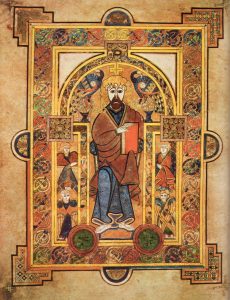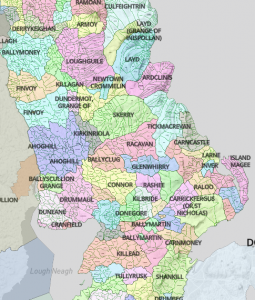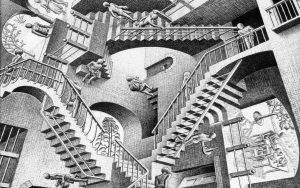Irish civil parishes are strange beasts. For good or ill, knowing about them is essential for Irish research.
They came into existence, as simple parishes, after the twelfth century attempt to tame the exotic Irish church and bring it into line with Roman norms. As well as having scandalous marriage laws, outrageous hairstyles, deadly book illustrators and a peculiar way of calculating the date of Easter, the early Irish church disregarded the Imperial Roman territorial divisions of parishes and dioceses. We preferred vast monastic holdings that resembled secular kingdoms in power and wealth, and were passed on, like kingdoms, from father(-Abbot) to son(-Abbot).

We eventually had clerical celibacy, parishes and manners put on us by the Anglo-Normans.
Until the sixteenth century, however, parishes were only in widespread use in the English-controlled areas of the East. The Reformation in Tudor England transformed the Church there into an arm of the state, and then they conquered the entire island. As a result, a parish structure was finally extended country-wide and became the bailiwick of the Anglican Church in Ireland, the Church of Ireland. Because church and state were so intertwined, these parishes then also became the geographic basis of public administration, hence “civil” parishes. For two centuries from roughly 1700 to 1900, tax records, militia levies, rentals and censuses were all based on the civil parish.
Why bring this up now? Because we’ve just implemented a major upgrade to the civil parish maps on this site. Maps were always important, because you need to know where the blasted parishes are, as well as what townlands they contain and which other parishes adjoin them. But the old maps were a little … underwhelming. With the new ones, you can zoom in and out, see where the constituent townlands are and best of all enjoy the whole thing in glorious Candy-Crush colour.

The colour began as an afterthought, but turned out to be a revelation. Many parishes have gained or lost townlands over the centuries and now consist of multiple separate areas. Colour makes the links between the various parts jump out. Have a look at Drumcolumb parish in Sligo, scattered in four distinct parts. Or my favourite, Shrule in Mayo, which incorporates a townland from the separate parish of Kilmainebeg, with that townland then incorporating a separate townland from Shrule. M.C Escher, eat your heart out.

All of this was only possible because of the wonderful work of OpenStreetMap, in particular the mappers behind www.townlands.ie, who made all their data open-source. For some extraordinary work by one of the people behind that site, have a look at Brian Hollinshead’s astonishing www.dublinhistoricmaps.ie. It is Map-Nut Nirvana. Not only does it include every single map of Dublin ever published, all overlaid on contemporary street plans, it also includes some extremely useful guides, for example to local registrars’ districts. As well as some deeply odd ones: Dublin Compressed Gas Filling Stations?
Once you begin to get a taste for this stuff …
Very interesting and informative piece. Thank you! I wonder if you know anyone who does genealogy research in Ireland? I’m stumped here in the USA attempting to find from where and when my great grandparents arrived here from Ireland. Can’t find the shipping records, and so on. Any information would be appreciated.
mike@youririshheritage.com is a good source.
Hello. I recommend Linda Keohane. Her email is: lindakeohane21@gmail.com
L. Crowley Moulis
Oh, boy! Oh boy oh boy oh boy!
This is terrific, and I do love the colors. However, I frequently struggle, when searching the Civil Records on Irish Genealogy, to know exactly what to choose from the “Civil Registration District/Office” dropdown. The civil parishes in your map don’t align to this dropdown box. Is there a map to help me with that?
Jim
Hi Jim
See https://www.johngrenham.com/places/plu_index.php
John
Enlightening and entertaining as ever, John. Míle buiochas.
As a fellow map-nut and intense researcher, these have been a Grenham-sent gift. Thanks John.
As usual, your blog contains a reference to outrageous marriage laws. Expansion of that I am sure would be absolutely fascinating.
Agreed, and can we add “deadly book illustrators” to the expansion list? Curious minds …
Thank you very much John. Great work!
John, really wonderful information every time you release a new article. Really enjoy them.
This is brilliant! It makes visualising where everything is in relation to everything else so much easier!
Thanks to all those involved.
Excellent article as usual
Can I have permission to share please
I tell anyone looking at Mayo that you have to learn the geography, and the various administrative divisions and as much local name material as you can because it does make a difference. Thanks for these new maps, so psyched! (Not counting when some parts became Mayo from Galway and what sources use which county names for that time period…)
I am in heaven I started my working life as a survey draftsperson and have loved maps ever since I am now an Historian and Archivist in the process of relocating to Ireland soon and seeing these Parish Maps has been wonderful. Thank you so much.
John – I’ve been searching most of life now for the compressed gas filling station records and thanks be to G-d! Because of johngrenham.com, I can finally move on with my pursuits!
You do the Lords work, John. You really do!
?
The colour-coding really does make a huge difference. I feel as though I finally (almost!) understand the civil parish of Doon, which crossed the border between Limerick and Tipperary, with seemingly random little bits in both counties.